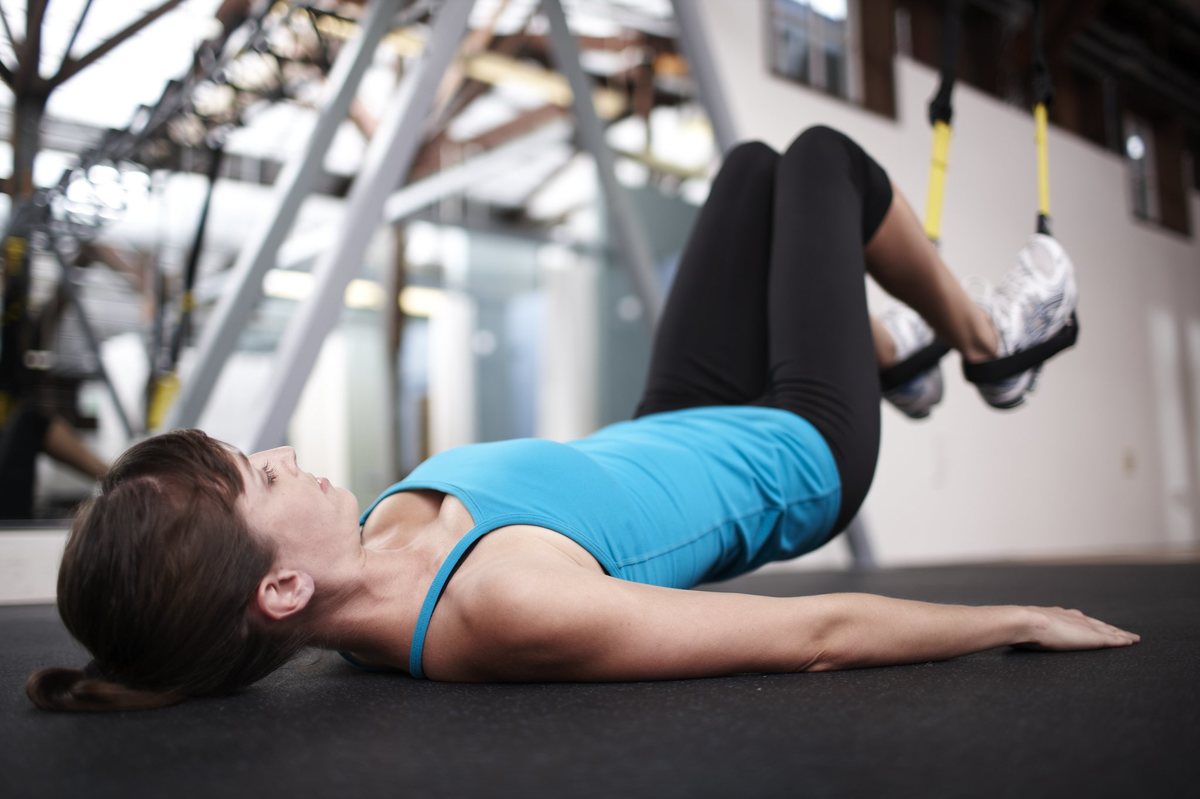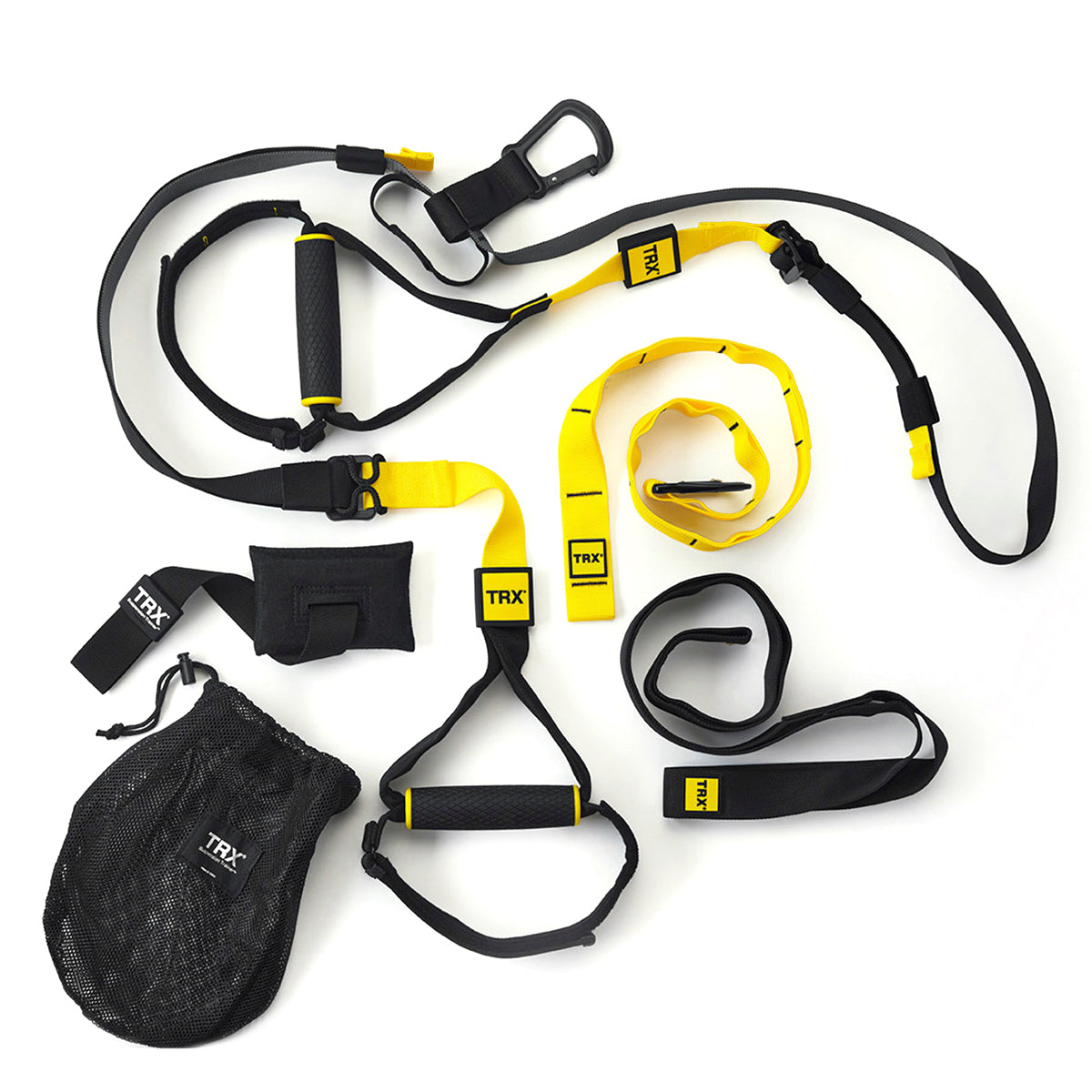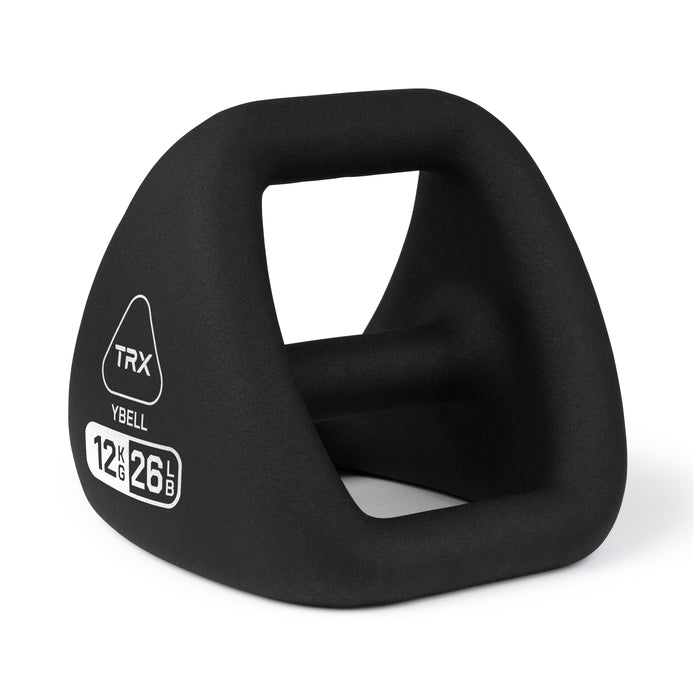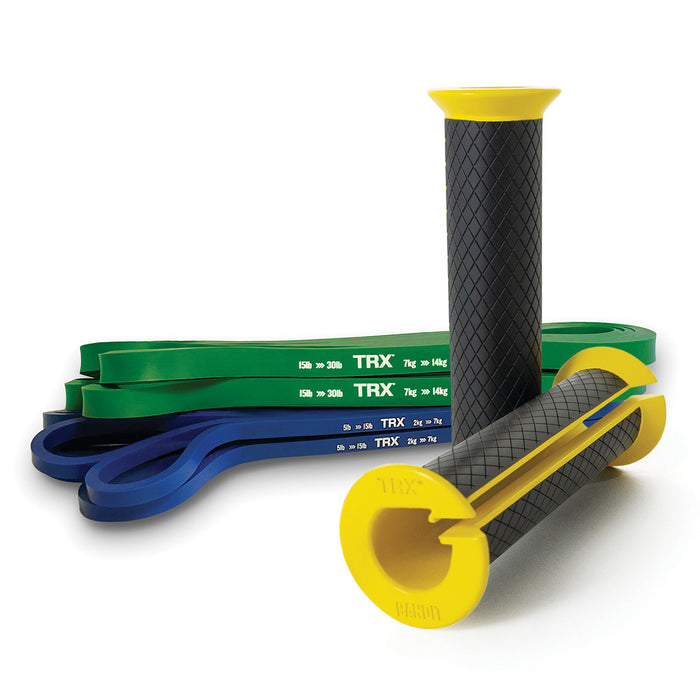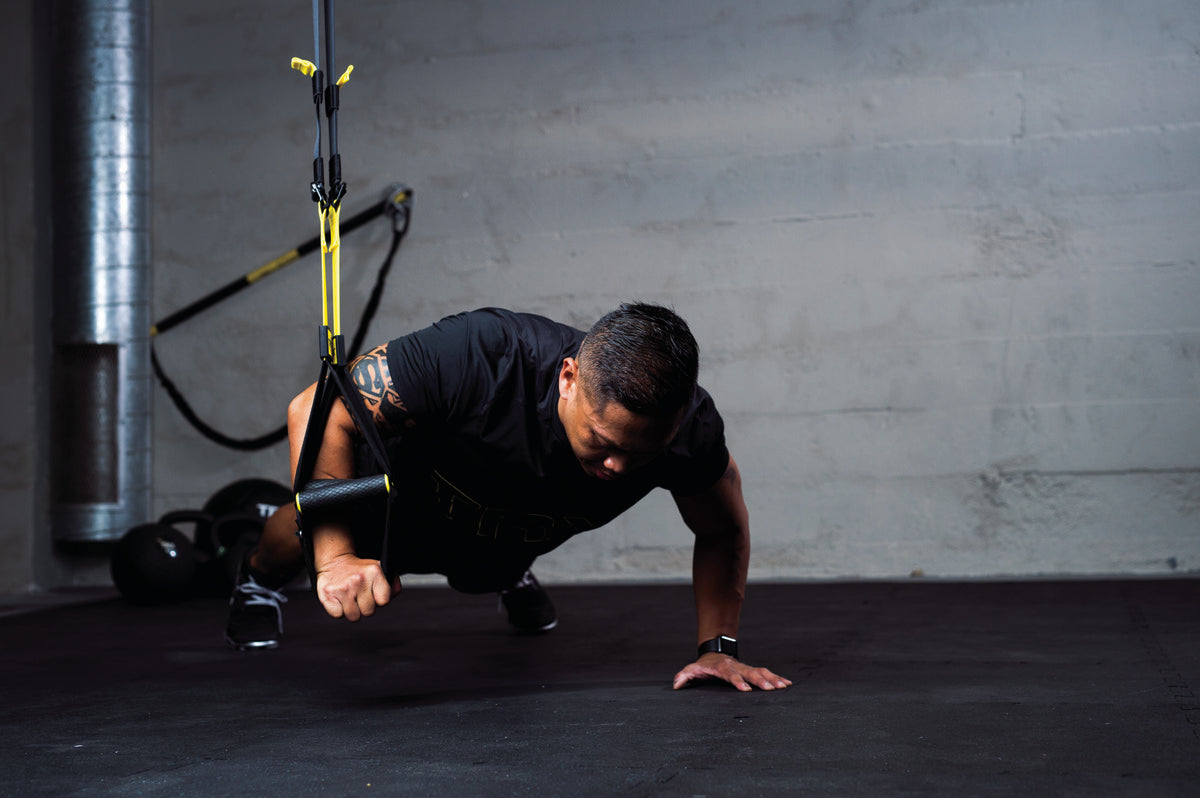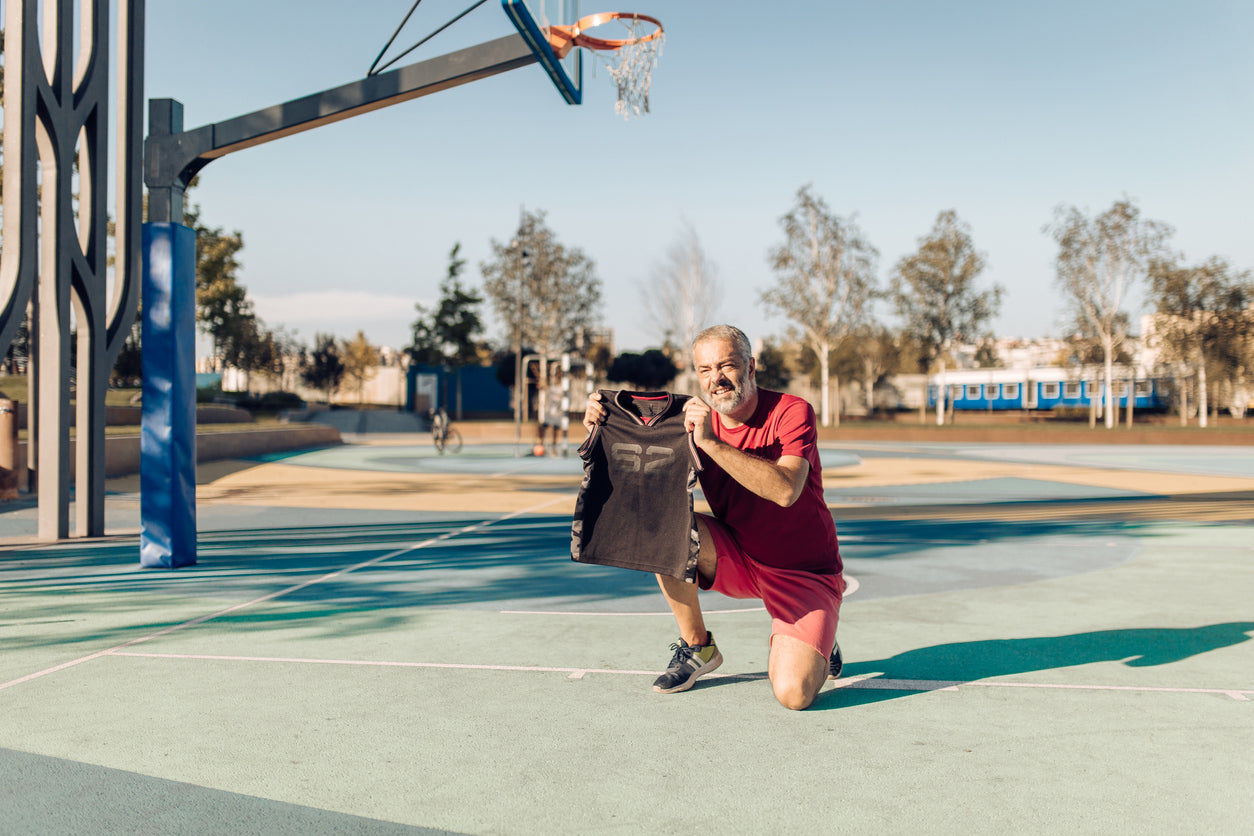When you want to exercise your hamstrings, you typically think of exercises that require the gym (squats, leg presses, etc.). But, what if we told you that you can exercise your hamstrings at home?
Today, we’re going to look at eleven hamstring exercises you can do from the comfort of your living room. Afterward, we’ll leave you with a sample at-home hamstring workout that you can do with minimal equipment. Are you ready? Let’s get started!
What You'll Need to Exercise Your Hamstrings at Home
When it comes to toning and strengthening your hamstrings at home, you might be pleasantly surprised to find that you don't need an extensive array of gym equipment. In fact, with just a few key tools, you can effectively target and work your hamstrings. Here, we'll explore the minimal equipment required for these exercises, including the TRX suspension trainer, resistance bands, and YBell.
TRX Suspension Trainer
The TRX suspension trainer is a versatile piece of equipment that can be easily anchored to a sturdy door frame, a tree branch, or a ceiling mount. This simple yet effective tool allows you to perform a wide range of hamstring exercises and provides a full body workout at home.
Leveraging your bodyweight for resistance the TRX provides support and balance, making it perfect for individuals of all fitness levels, and it's especially great for those who are new to hamstring-focused exercises.
Strength Bands
Resistance bands are commonly used for strength training at home. They are an inexpensive and portable option and allow you to tailor your exercise intensity to your fitness level. You can attach them to door anchors or even use your body weight as an anchor for exercises.
YBell
The YBell is a relatively newer piece of equipment but has gained popularity for its versatility. It's a 4-in-1 piece of fitness equipment that combines a kettlebell, dumbbell, double grip medicine ball, and push-up stand. Its ergonomic design makes it comfortable to use, and it's particularly useful for dynamic hamstring exercises.
With these tools at your disposal, you'll have the essentials needed to effectively target and strengthen your hamstrings from the comfort of your home. No need for expensive gym memberships or bulky machines; just a few key items that can easily fit into your home workout space.
Related: How to Build a Home Gym
The Best Hamstring Exercises to Do at Home
TAKE OUR TRAINING QUIZ
- TRX Hamstring Runner
- TRX Hamstring Curl
- Dumbbell Romanian Deadlift
- Resistance Band Good Mornings
- Glute Bridges
- TRX Hamstring Bridge
- Weighted Donkey Kicks
- Resistance Band Hamstring Curls
- Dumbbell Hip Thrusts
- TRX Single-Leg Deadlifts
- Single-Leg Romanian Deadlift
The beauty of these exercises is that they’re suitable for individuals at different stages of their fitness journey. Whether you're just starting or you've been working on your hamstring strength for a while, you'll find exercises that suit your skill level.
11. TRX Hamstring Runner
The TRX Hamstring Runner is an exceptional exercise for strengthening the hamstrings, as well as engaging the core and improving overall stability. This exercise offers the advantage of using your body weight for resistance, making it accessible and effective for individuals of various fitness levels. By performing the TRX Hamstring Runner regularly, you can enhance your hamstring strength and contribute to better lower-body functionality.
To begin, you'll need to anchor your TRX suspension trainer to a secure point, such as a door frame, a sturdy ceiling mount, or a tree branch. Ensure that the straps are adjusted to mid-calf length.
Performing the TRX Hamstring Runner exercise involves lying on your back facing the anchor point, alternating hamstring curls. Here's a step-by-step guide:
- Sit down facing the anchor point, extend your legs forward, and place your heels in the TRX foot cradles, securing your feet.
- Lie down on your back while maintaining tension in the TRX straps and keeping your legs fully extended.
- Engage your core muscles and tuck your tailbone as you lift your hips away from the floor.
- Begin by bending one knee toward your hip while keeping the other leg straight and elevated. Pull the heel of the bent leg towards your glutes using your hamstrings.
- Alternate legs in a controlled manner, extending the bent leg back to the starting position and repeating the movement with the other leg.
- Maintain a fluid and rhythmic motion, smoothly alternating between legs while avoiding excessive swinging or jerking motions.
- Focus on stability, ensuring your hips remain stable and your body aligned throughout the exercise.
- Maintain equal pressure through both heels to avoid the straps from sawing.
For beginners, start with 3 sets of 10-12 repetitions. As you progress, you can increase the number of sets or repetitions. For advanced individuals, aim for 3-4 sets of 16-20 repetitions. Remember to maintain proper form and control throughout the exercise to maximize its effectiveness while minimizing the risk of injury.
10. TRX Hamstring Curl
The TRX Hamstring Curl is another fantastic hamstring exercise that not only targets your hamstrings but also engages your glutes and core muscles. It's an excellent exercise for building strength in the back of your legs while enhancing stability and balance.
Start by anchoring the TRX suspension trainer to a secure point, such as a door frame or ceiling mount. The straps should be set to mid-calf length.
Performing the TRX Hamstring Curl involves lying on your back facing the anchor point, performing hamstring curls with both legs simultaneously. Here are the steps:
- Sit down facing the anchor, extend your legs forward, and place your heels in the TRX foot cradles, securing your feet.
- Lie down on your back while maintaining tension in the TRX straps and keeping your legs fully extended.
- Engage your core muscles and tuck your tailbone as you lift your hips away from the floor.
- Begin the movement by flexing both knees simultaneously, bringing your heels towards your glutes by contracting your hamstrings.
- Control the movement as you slowly extend your legs back to the starting position, maintaining stability and control.
- Spend time under tension to gain the most from the exercise. Ensure a smooth and controlled motion, avoiding excessive swinging or jerking movements.
- Keep your hips stable and your body aligned throughout the exercise, focusing on maintaining proper form and balance.
For beginners, aim for 2-3 sets of 10-12 repetitions. As you become more comfortable and stronger, you can increase the sets and repetitions. Advanced individuals can target 3-4 sets of 12-15 repetitions.
9. Dumbbell Romanian Deadlift
The Dumbbell Romanian Deadlift is a compound exercise that targets the hamstrings, glutes, and lower back, making it a fantastic choice for overall lower body development. It also enhances posture and core stability. Using dumbbells for this exercise provides an extra challenge as it demands proper balance and control, ultimately helping you build stronger and more toned hamstrings.
Dumbbells are an excellent addition to hamstring exercises because they provide an opportunity for progressive resistance. You can easily adjust the weight according to your fitness level, making dumbbells an ideal choice for anyone looking to challenge and strengthen their hamstrings.
- Stand with your feet shoulder-width apart, holding a dumbbell in each hand with your palms facing your thighs.
- Keep your back straight, shoulders back, and chest up.
- Engage your core for stability and balance, and maintain a soft bend in your knees.
- Begin the movement by hinging at your hips, pushing your glutes back, and keeping the priority on pushing your hips as far back as possible rather than reaching for the floor with your arms. This keeps the emphasis in your hamstrings rather than your lower back.
- Go as far as your flexibility allows. Ideally, you'll aim to bring the dumbbells to around mid-shin level.
- Push through your heels, engaging your hamstrings and glutes, to return to the upright position.
For beginners, start with 2-3 sets of 8-10 repetitions, using a weight that is challenging but manageable. As you progress, increase the weight and aim for 3-4 sets of 10-12 repetitions. More advanced individuals can go for higher weights and repetitions as they become stronger and more experienced but always prioritize proper form and control.
8. Resistance Band Good Mornings
Resistance Band Good Mornings primarily target the hamstrings and lower back, helping to strengthen the posterior chain. This exercise also improves hip mobility and posture, making it an effective choice for individuals looking to enhance their overall lower body strength and stability.
- Begin by stepping on the resistance band with your feet shoulder-width apart. Hold the other end of the band behind your neck, resting it on your shoulders.
- Keep your back straight, shoulders back, and core engaged.
- Hinge at your hips, pushing your buttocks back
- Work with your range of motion aiming to lower your torso until it's parallel to the ground.
- Maintain a slight bend in your knees throughout the movement.
- Engage your hamstrings and glutes to return to the starting position, maintaining control and keeping your back straight.
When selecting resistance bands for Good Mornings, consider the following recommendations tailored to different fitness levels:
- Light Resistance Band: Ideal for beginners or individuals recovering from injuries. This band provides minimal resistance, making it suitable for those new to resistance training or requiring rehabilitation.
- Medium Resistance Band: Suitable for intermediate users who have developed some strength and endurance. It offers moderate resistance, providing a balance between challenging the muscles without being too strenuous.
- Heavy Resistance Band: Suited for advanced users seeking higher intensity and increased resistance. This band offers substantial tension, making it suitable for individuals looking to further challenge their strength and stamina.
For beginners, start with 2-3 sets of 10-12 repetitions. Intermediate users can aim for 3-4 sets of 12-15 repetitions, while advanced individuals may target 4 sets of 15-20 repetitions. Adjust the resistance and repetitions based on your comfort and experience level, focusing on maintaining proper form and control throughout the exercise.
7. Glute Bridges
Glute Bridges are an excellent exercise for targeting the hamstrings, glutes, and lower back. They are also known for improving core stability and posture. This exercise is particularly beneficial for individuals looking to strengthen their lower body and alleviate lower back pain. Plus, it's a fantastic way to build better mind-muscle connections and increase your hip mobility. This bodyweight exercise requires no additional equipment, making it incredibly accessible.
- Lie on your back with your knees bent and feet flat on the floor, hip-width apart. Place your arms by your sides, palms facing down.
- Push through your heels, engaging your glutes and hamstrings, to lift your hips off the ground.
- Raise your hips until your body forms a diagonal line from your shoulders to your knees.
- Hold the top position for a moment, squeezing your glutes and hamstrings.
- Lower your hips back to the ground, maintaining control and a straight back.
Variations to Make the Exercise More Challenging:
- Single-Leg Glute Bridges: Lift one leg off the ground while performing the exercise for increased intensity.
- Weighted Glute Bridges: Hold a dumbbell or other weighted object on your hips to add resistance.
- Elevated Glute Bridges: Place your feet on an elevated surface, like a bench, to increase the range of motion and difficulty.
For beginners, aim for 2-3 sets of 12-15 repetitions. Intermediate users can target 3-4 sets of 15-20 repetitions. To make it more challenging, increase the repetitions or try one of the variations mentioned above.
Related: Shoulder Workout at Home
6. TRX Hamstring Bridge
The TRX Hamstring Bridge is a challenging exercise that targets the hamstrings, glutes, and lower back, making it an excellent choice for overall lower body strengthening. This exercise also enhances core stability and improves hip mobility. By using the TRX, you can increase the range of motion and intensity, making it suitable for both beginners and advanced users.
Before delving into the TRX Hamstring Bridge, it's essential to set up the TRX suspension trainer correctly. Attach the TRX straps to a secure anchor point, and adjust the straps to mid-calf length.
- Start by sitting facing your anchor point and place your heels in the TRX foot cradles.
- Lie on your back and bend your knees at a 90-degree angle.
- Place your arms by your sides, palms facing down, and engage your core for stability.
- Push through your heels and lift your hips off the ground, creating a diagonal line from your shoulders to your knees.
- Keep your core engaged and your glutes and hamstrings contracted as you raise your hips.
- Hold the top position for a moment before lowering your hips back to the ground.
For beginners, aim for 2-3 sets of 6-8 repetitions. As you progress, you can increase the sets and repetitions. Intermediate users can target 3-4 sets of 10-12 repetitions. Advanced individuals may aim for 4 sets of 12-15 repetitions. The TRX Hamstring Bridge offers a great balance between ease of use and challenging workout capabilities.
5. Weighted Donkey Kicks
Weighted Donkey Kicks primarily target the hamstrings, glutes, and lower back, making it a potent exercise for building lower body strength. It also helps to improve hip mobility and posture and enhances core stability. The added resistance not only increases muscle activation but also allows for progressive overload, which is crucial for long-term progress.
- Begin on all fours with your hands under your shoulders and knees under your hips.
- Place a dumbbell in the crease of the back of your knee or weight to one ankle.
- Lift your knee with the weight attached toward the ceiling, keeping your foot flexed.
- Squeeze your glutes and hamstrings at the top of the movement.
- Lower your knee back to the starting position with control.
- Perform the exercise for the desired number of repetitions and then switch to the other leg.
For weighted donkey kicks, keep these things in mind:
- For beginners, start with just bodyweight, nail your form, and then add light weights (3-5 lbs).
- Intermediate users can increase the weight and use moderate dumbbells/ ankle weights (5-8 lbs).
- To make the exercise more challenging, increase the weight or try variations such as the straight-leg weighted donkey kick.
For beginners, aim for 2-3 sets of 10-12 repetitions per leg. Intermediate users can target 3-4 sets of 12-15 repetitions. Advanced individuals may go for 4 sets of 15-20 repetitions or more. Adjust the weight, sets, and repetitions according to your fitness level and preferences, always prioritizing proper form and control to achieve the best results.
4. Resistance Band Hamstring Curls
Resistance band hamstring curls offer a dynamic way to strengthen and sculpt the hamstring muscles. Unlike traditional exercises, these curls utilize variable resistance, where the intensity increases as the band is stretched further. This unique aspect demands greater control and engagement from the muscles throughout the entire range of motion. As the band stretches, the resistance intensifies, compelling the hamstrings to work harder during both the concentric (lifting) and eccentric (lowering) phases of the exercise.
- Anchor the resistance band to a sturdy point, at approximately knee height or slightly lower, and secure the other end around your ankles.
- Lie face down and place your hands on the ground to support your upper body.
- Set up with the anchor point behind you to create tension in the band.
- Engage your core muscles to stabilize your body throughout the exercise. This engagement will also help in maintaining proper form
- Initiate the movement by bending your knees, and bringing your heels towards your glutes while keeping your hips and upper body steady. Contract your hamstrings to perform the curling motion against the resistance of the band.
- Flex your knees as far as comfortably possible, achieving a full contraction of the hamstrings. Hold briefly at the peak contraction.
- Slowly extend your legs back to the starting position, resisting the band's pull, and maintain tension on the hamstrings.
For beginners, start with 2-3 sets of 10-12 repetitions. As you become more comfortable, you can increase the sets and repetitions. More advanced individuals can aim for 3-4 sets of 12-15 repetitions. Adjust the resistance and the number of sets and repetitions based on your fitness level and goals, always focusing on maintaining proper form and control throughout the exercise.
Related: Back Exercises You Can Do at Home
3. Dumbbell Hip Thrusts
Widely praised for its targeted approach in engaging key muscle groups, particularly the glutes and hamstrings, this exercise has gained recognition in fitness circles for its ability to enhance strength and stability. By isolating these crucial muscle groups, dumbbell hip thrusts not only promote muscle growth but also foster better hip mobility and core stability.
Holding dumbbells on the hips during hip thrusts adds a stabilizing factor, requiring better control and stability throughout the movement. This engagement of stabilizer muscles contributes to overall strength and control, promoting better exercise performance. Using dumbbells helps in maintaining balanced muscle engagement during the exercise. It ensures that both sides of the bodywork equally, preventing muscle imbalances.
- Begin by sitting on the ground with your upper back against a stable bench or elevated surface. Place your feet flat on the floor, hip-width apart.
- Hold a dumbbell with both hands on your hips, or use two dumbbells, one on each hip.
- Lean your upper back against the bench and roll the dumbbell(s) toward your hips.
- Push through your heels, lifting your hips toward the ceiling. Ensure your body forms a straight line from your shoulders to your knees.
- Squeeze your glutes and hamstrings at the top of the movement.
- Lower your hips back to the ground with control.
- Beginners can start with a light to moderate weight (10-20 lbs per dumbbell).
- Intermediate users can increase the weight to a moderate to heavy range (20-30 lbs per dumbbell).
- Advanced individuals may use heavier dumbbells (40 lbs or more).
For beginners, aim for 2-3 sets of 8-10 repetitions. As you become more experienced, increase the sets and repetitions. Intermediate users can target 3-4 sets of 10-12 repetitions, and advanced individuals can aim for 4 sets of 12-15 repetitions.
Related: Bicep Workouts at Home
2. TRX Single-Leg Deadlifts
TRX Single Leg Deadlift—an exercise that blends strength, balance, and finesse into one seamless movement. Forget the conventional weightlifting routines; this exercise, powered by the TRX suspension trainer, introduces a whole new dimension to lower-body workouts. It's more than just targeting your hamstrings and glutes; it's a full-body challenge that sharpens your stability, hones your core, and fine-tunes your muscle control.
Before diving into TRX Single-Leg Deadlifts, it's crucial to set up the TRX suspension trainer correctly:
- Attach the TRX straps to a secure anchor point, such as a door frame or ceiling mount.
- Ensure the straps are fully shortened, with the adjustment tabs to the top.
Now, let’s take a look at how to do the exercise.
- Stand facing the anchor point with your feet hip-width apart. Hold the TRX handles in each hand, palms facing down.
- Stand on one leg as you lift your other knee toward your chest
- Hinge at your hips as you extend the lifted leg straight behind you.
- Keep your arms straight, palms pressing into the handles to aid balance.
- Lower your body until it's parallel to the ground or as far as your flexibility allows.
- Flex the foot of your lifted leg and keep your hips and shoulders square on the ground
- Keep a slight bend in your standing leg throughout the movement.
- Push through the grounded foot and return to the starting position, maintaining control.
For beginners, start with 2-3 sets of 8-10 repetitions per leg. As you become more proficient, you can increase the sets and repetitions. Intermediate users can target 3-4 sets of 10-12 repetitions per leg. Advanced individuals may aim for 4 sets of 12-15 repetitions.
1. Single-Leg Romanian Deadlifts
One of the remarkable features of the Single-Leg Romanian Deadlift is its simplicity; it can be done with just your body weight, requiring no additional equipment. This makes it a fantastic exercise for those who prefer minimalistic and effective home workouts. All you need is a stable surface, and you're ready to get started. Single-leg Romanian Deadlifts are a valuable exercise that targets the hamstrings, glutes, lower back, and core. This exercise helps strengthen the posterior chain and improves balance and stability.
- Begin by standing with your feet together.
- Shift your weight onto one leg while keeping a slight bend in the knee.
- Hinge at your hips and extend your non-weight-bearing leg straight behind you. Your body should form a straight line from your head to your extended foot.
- Keep your back straight and core engaged. Focus your eyes on a fixed point for balance.
- When you feel a stretch in your hamstrings, reverse the movement and return to the starting position.
For beginners, start with 2-3 sets of 10-12 repetitions per leg. As you gain confidence and strength, you can increase the sets and repetitions. Intermediate users can target 3-4 sets of 12-15 repetitions per leg. Advanced individuals may aim for 4 sets of 15-20 repetitions per leg.
Try This Sample At-Home Hamstring Workout Today
Now that you know the best hamstring exercises you can do at home, it’s time to put them together for a sample at-home hamstring workout. The best part is you only need thirty minutes to do it.
- Warm-up: 5 minutes of light cardio (like jogging in place or jumping jacks)
- TRX Hamstring Curl: 2 sets of 10 reps, rest for 30 seconds between sets
- Dumbbell Romanian Deadlift: 2 sets of 10 reps, rest for 30 seconds between sets
- Glute Bridges: 2 sets of 10 reps, rest for 30 seconds between sets
- Resistance Band Good Mornings: 2 sets of 10 reps, rest for 30 seconds between sets
- Weighted Donkey Kicks: 2 sets of 10 reps per leg, rest for 30 seconds between sets
You can also program this into other lower-body workouts that you do at home. For inspiration, you can try some free at-home leg workouts with the TRX Training Club app!


